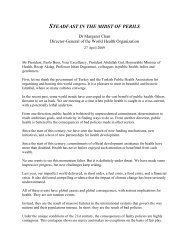The Evolution of HTA in Emerging Markets Health-Care ... - TREE
The Evolution of HTA in Emerging Markets Health-Care ... - TREE
The Evolution of HTA in Emerging Markets Health-Care ... - TREE
You also want an ePaper? Increase the reach of your titles
YUMPU automatically turns print PDFs into web optimized ePapers that Google loves.
OHE Consult<strong>in</strong>g Report for PhRMA<br />
5 January 2011<br />
<br />
proposals considered out <strong>of</strong> the scope <strong>of</strong> CITEC<br />
In total, there are 89 results (40%) from submissions with a result. <strong>The</strong>re rema<strong>in</strong> 133 technologies<br />
for evaluation.<br />
Also, at CITEC, there are 74 studies under development supported by the M<strong>in</strong>istry <strong>of</strong> <strong>Health</strong>.<br />
Twenty-‐four chemotherapeutic agents are under evaluation. Currently, SUS pays a different<br />
diagnosis-‐related group (DRG) payment for each type <strong>of</strong> cancer but not the drugs separately. Eighty-six<br />
therapeutic protocols are under review: 53 for update and 33 be<strong>in</strong>g developed. Fifteen<br />
academic <strong>in</strong>stitutions are <strong>in</strong>volved <strong>in</strong> the studies.<br />
Manufacturers may request directly for the MS to evaluate their technologies, but unlike NICE, they<br />
cannot participate or give op<strong>in</strong>ions to the process <strong>of</strong> analysis. <strong>The</strong>re are public consultations about<br />
some po<strong>in</strong>ts <strong>of</strong> the Policy for Management <strong>of</strong> <strong>Health</strong> Technologies and about the cl<strong>in</strong>ical protocols<br />
and therapeutic guidel<strong>in</strong>es, when manufacturers can give their op<strong>in</strong>ion, as well as any other<br />
<strong>in</strong>stitution or <strong>in</strong>dividual.<br />
In practice, most <strong>of</strong> the time, manufacturers def<strong>in</strong>e which new technologies should be evaluated by<br />
the government s<strong>in</strong>ce the government has not clearly def<strong>in</strong>ed its priorities and what will or will not<br />
be evaluated. However, public bodies, medical associations and patient groups may also request for<br />
the evaluation <strong>of</strong> new technologies.<br />
New technologies not considered as high-‐cost may also be <strong>in</strong>corporated by states or municipalities<br />
<strong>in</strong> their own Lists <strong>of</strong> Essential Medic<strong>in</strong>es. Besides pharmaceutical assistance, new procedures and<br />
exams may be also <strong>in</strong>corporated <strong>in</strong> the medium and high complexity program for ambulatory and<br />
<strong>in</strong>patient care. <strong>The</strong>se processes do not go through CITEC for evaluation.<br />
In summary, the health technology assessment <strong>of</strong> medic<strong>in</strong>es <strong>in</strong> Brazil is a complex process. First,<br />
market<strong>in</strong>g authorization <strong>of</strong> new drugs is tied to pric<strong>in</strong>g, carried out by two separate units <strong>in</strong> ANVISA.<br />
After the first unit establishes that drug has sufficient efficacy, safety, and production quality, the<br />
pric<strong>in</strong>g unit (CMED) assesses the <strong>in</strong>novative status <strong>of</strong> the drug. This assessment will normally <strong>in</strong>clude<br />
a submission <strong>of</strong> evidence from the manufacturer. If the new drug is deemed to be <strong>in</strong>novative<br />
(Category 1), then the price will be established based on <strong>in</strong>ternational reference pric<strong>in</strong>g.<br />
If the drug is similar to other drugs (Category 2), then price will be based on <strong>in</strong>ternal reference<br />
pric<strong>in</strong>g, rely<strong>in</strong>g on the prices <strong>of</strong> those similar drugs <strong>in</strong> Brazil. This market<strong>in</strong>g authorization puts the<br />
drug <strong>in</strong> the marketplace at that price, and there are no guarantees that private <strong>in</strong>surance<br />
(Supplementary <strong>Health</strong>care) will cover these drugs...<br />
<strong>The</strong> drug will not necessarily be covered <strong>in</strong> the public system (SUS) until the drug’s cl<strong>in</strong>ical impact,<br />
cost-‐effectiveness, and budget impact are reviewed by CITEC.<br />
In the private system, the process is further complicated by different treatment <strong>of</strong> <strong>in</strong>travenous and<br />
non-‐<strong>in</strong>travenous drugs. <strong>The</strong> private <strong>in</strong>surance system is required to cover <strong>in</strong>travenous drugs, but<br />
important oral oncology drugs can be excluded.<br />
78








